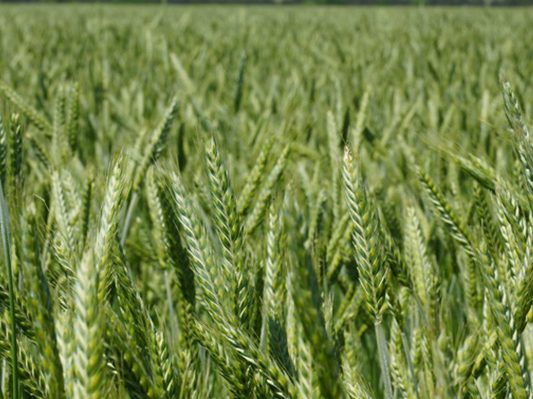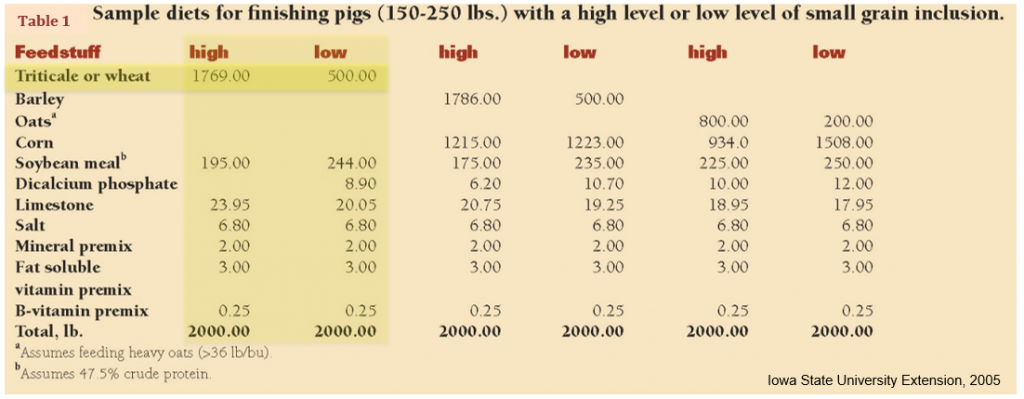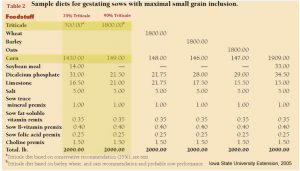Small Grains, Large Gains: Feeding Triticale to Pigs
When added to a crop rotation, triticale offers many benefits to farmers in the Corn Belt. It can boost the yields of other cash crops and provide livestock feed, reducing feed costs from off-farm sources. Triticale’s strength is in its versatility – it can be grazed; used as a cover crop, or as feed or silage; or it can harvested for straw. This blog covers the possibilities of including triticale in pig rations. In studies from Florida, North Dakota and Canada, grow-finish pigs fed triticale performed similarly to pigs fed corn-based diets when rations were adequately balanced.

“To diversify the Iowa crop rotation we need a demand. If we can show that pigs could utilize triticale, it can pull farmers to grow it.” –Dr. Mark Honeyman
Triticale is a hybrid of wheat and rye that combines the yield and grain quality of wheat with the disease resistance and a tougher tolerance for environmental stressors of rye. Iowa State agronomists recommend planting triticale before September 25 in northern Iowa and before October 5 in southern Iowa to obtain the best dry matter production and highest grain yield.
Nutritional Quality and Health Benefits
Modern triticale varieties are an excellent replacement for corn, because of their higher lysine content – it has a higher feed value than other cereal grains. Average lysine concentration for triticale is 0.39% compared with 0.26% in corn. This means diets should be balanced on a lysine basis, rather than a crude protein basis. If diets containing triticale are formulated to meet crude protein requirements only, lysine levels will be inadequate to meet ideal pig performance.
Feeding triticale with more bioavailable phosphorous – over 30% more than corn – reduces the amount of dicalcium phosphate supplementation in the diet. Since the phosphorous in triticale is more bioavailable than in corn less phosphorous is lost and excreted in manure.
Although appearance might suggest triticale to be high in fiber, its crude fiber content is actually similar to that of corn.
Nutrient analysis comparing corn and wheat (as-fed basis) |
||
| Corn | Triticale | |
| Crude Protein (%) | 8.3 | 12.5 |
| Energy (ME, kcal/kg) | 3,420 | 3,180 |
| Lysine (%) | 0.26 | 0.39 |
| Crude Fiber (%) | 2.5 | 2.8 |
| Calcium (%) | 0.03 | 0.05 |
| Phosphorus (%) | 0.28 | 0.33 |
| Bioavailability of Phosphorus (%) | 14.0 | 46.0 |
| Source: Iowa State University Extension and Outreach, 2005 and University of Florida – IFAS Extension, 2000 | ||
Feeding Triticale in Different Production Phases
It is critical to know the variety and its traits when growing triticale and using it in swine diets. Like rye, triticale is susceptible to ergot. Along with ergot, triticale is also prone to infection by Fusarium when conditions are warm and wet during flowering and early grain development. If the grain is visibly infected, test it for mycotoxins, avoid feeding to the breeding animals and dilute it with toxin-free grain if you must feed it.
Triticale should be ground (medium to coarse) or rolled for use in swine diets. Finely ground triticale is not desirable because it readily absorbs moisture from the air and from the pigs’ saliva, which can result in feed spoilage and reduced feed intake.
| Grain | Starters (less than 60 lbs.) | Grow-Finish (below 125 lbs.) | Gestating Sows | Lactating Sows |
| Triticale | 10-30% | 40-95% | 90% | 40% |
| Compiled from the Tri-State Swine Nutrition Guide, Iowa State University Extension’s Feeding Small Grains to Swine, and Small Grains for Livestock. | ||||
When mixing your own feed, triticale can replace 100 pounds of soybean meal (44%) per ton over comparable corn-based diets. When using a commercial feed supplement comprised of protein, vitamins and minerals, consider triticale not only as a replacement for corn, but as a partial replacement for the supplement as well. Table 1 shows sample diets for feeding finishing pigs. Table 2 shows sample diets for gestating sows.

Table 1: The table above, highlights finishing pig rations; one with a high inclusion rate of triticale (88%) and one with a low inclusion rate of triticale (25%).
An Iowa State University (ISU) study compared a triticale-based diet to a corn-soybean based diet feeding both during summer and winter. Triticale was fed at 0, 40, and 80% of the total diet weight to grow-finish pigs housed in deep-bedded hoop barns. The rations included Tritical®815, a winter variety, and soybean meal. The pigs resulted with average daily gains and meat quality similar to pigs fed a corn-soybean-based diet. Yet, pigs fed triticale ate more feed resulting in lower feed efficiency.

Table 2: The table above, highlights gestating sow rations with and without the inclusion of triticale.
“Pigs fed triticale took a few more days to reach market weight than the pigs the on corn-soybean based diet. During the summer, average daily gain decreased as triticale inclusion increased, but during winter gains were similar, “shares Dr. Mark Honeyman an animal scientist at Iowa State University who conducted the study. “Similar to how your mother gives you oatmeal to keep you warm in the winter – due to the heat increment from fiber digestion – feeding triticale to pigs during winter will help keep them warm.” A similar study was conducted at The University of Florida.
What is the economic value of growing triticale?
An enterprise budget published by Iowa State University’s agronomy department evaluated the full economic cost and estimated returns of growing winter triticale in Iowa as part of a three-year crop rotation. Budget projections show a per acre net return of -$8.92 for forage triticale types, $16.14 for intermediate types (forage and grain), and $39.06 for grain type triticale (used both as grain and straw).
What is the cost of purchasing triticale? Albert Lea Seed in Minnesota and Welter Seed and Honey Company in Onslow carry both conventional and organic varieties of triticale classes. Both Albert Lea’s conventional and organic winter triticale seed is priced at $23 per 50-pound bag. Welter Seed and Honey’s winter triticale seed, conventionally raised, is priced at $17 per 50-pound bag, while organic seed costs $23 per 50-pound bag. Using the recommended seeding rate of 100-120 pounds per acre (drilling about ½ to 1½ inch deep), expect to pay between $35 and $55 per acre for conventional, and between $46 and $55 per acre for organic.
If you are searching for additional businesses that sell, buy and clean small grains in Iowa and the Midwest, check out our Small Grains Business Directory for more information.
Other blogs in our feeding small grains to pigs series:
feeding Barley to pigs Feeding Oats to Pigs

